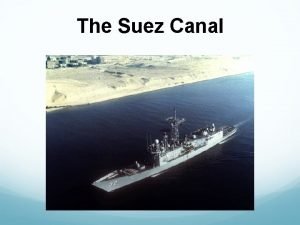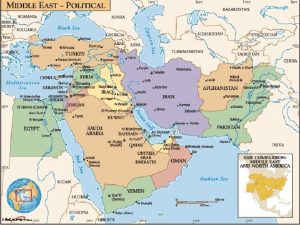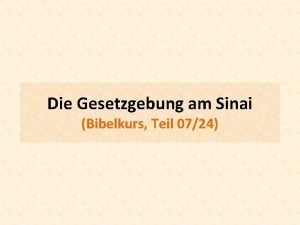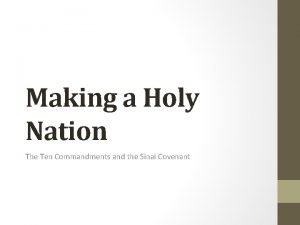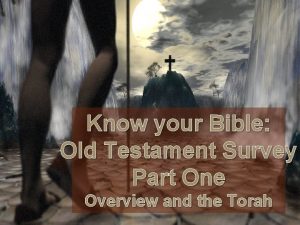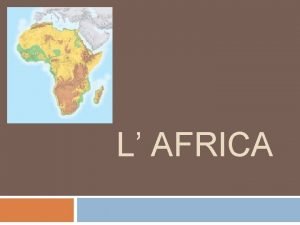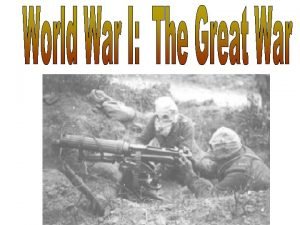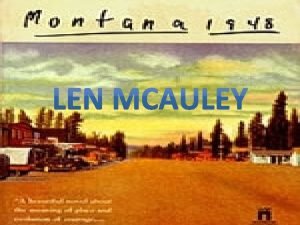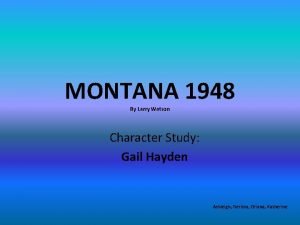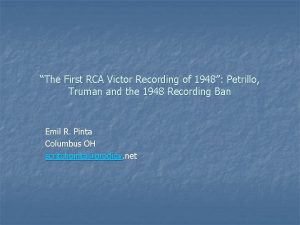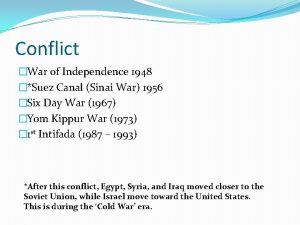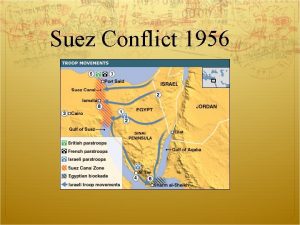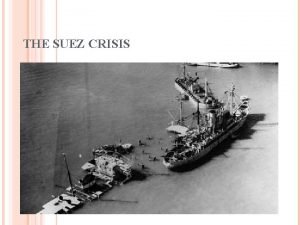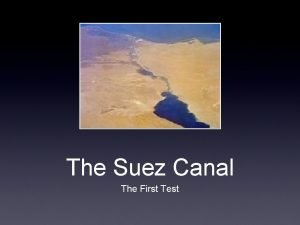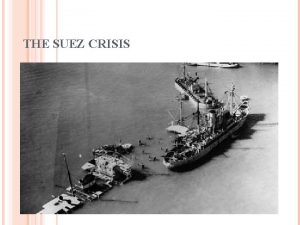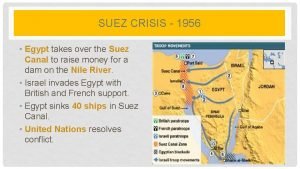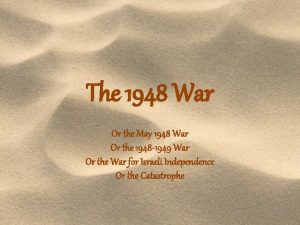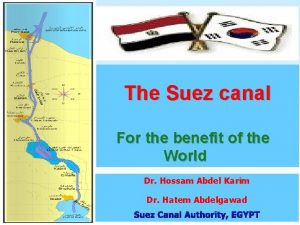Conflict War of Independence 1948 Suez Canal Sinai



















































- Slides: 51

Conflict �War of Independence 1948 �*Suez Canal (Sinai War) 1956 �Six Day War (1967) �Yom Kippur War (1973) � 1 st Intifada (1987 – 1993) *After this conflict, Egypt, Syria, and Iraq moved closer to the Soviet Union, while Israel move toward the United States. This is during the ‘Cold War’ era.

War of Independence

Palestinian Homeland • • • There is no such thing as Palestine today The Palestinians were forced out of their homes for the Jews to take over Israel’s Law of Return granted citizenship to every Jew that wanted to be a part of Israel In 1947, the UN set up a partition plan in which there would be a Jewish state and an Arab state The Jews accepted in order to get their homeland, while the Arabs rejected If the Arabs had accepted they would have had a “Palestinian homeland” for almost 60 years

1948 War (1948) �Israel declared independence �Egypt, Jordan, Lebanon, Syria and Iraq attacked Israel �Israel gained land. �Egypt gained Gaza Strip �Jordan gained West Bank and Jerusalem �Hundreds of thousands of Palestinians and Jews became refugees

Resolution 194 �Passed near the end of the Arab Israeli war of 1948 �Was an attempt to deal with the situation over Palestine and keep peace in the region �Called for Protection and free access to all holy places �Demilitarization and UN control over Jerusalem �Free access to Jerusalem �Most importantly, the return of all refugees, and right to live peacefully among Israeli neighbors. Also, compensation for the property of those who choose not to return

Who Supported Resolution 194 �The Palestinians supported Resolution 194 because it allowed for their return to their homes in peace. �Israel however did not fully accept it and was trying to find loopholes in the clause stating for the return of refugees.

Why did Resolution 194 Fail �Resolution 194 failed because it was interpreted many different ways �interpreted by the Arab and Palestinians as a pass to go back to the homes they were driven out of �Israeli side argued that the Arabs didn't want to live peacefully so the article could not work �Resolution 194 isn’t binding, so it couldn’t be enforced anyway

Suez Canal (Sinai) War

USSR– Premier Nikita Khrushchev England – Prime Minister Anthony Eden Ben-Gurion C O L D W A R Abdel Nasser United States – President Dwight Eisenhower P E R I O D

Sinai War 1956 � Egyptian forces blocked the Straits of Tiran � Egypt encouraged groups of Palestinian fighters to attack Israel from Egyptian territory. Israeli forces constantly made cross-border raids in retaliation � October 29, 1956 -Israeli troops invaded Egypt's Sinai Peninsula and quickly overcame opposition as they raced for Suez. � Britain and France-offered to temporarily occupy the Canal Zone 10 mile buffer on either side would separate the Egyptian forces from the Israelis. � October 31 -Egypt was attacked and invaded by the military forces of Britain and France � The war itself lasted for only a week, and invading forces were withdrawn within the month.

Six Day War

Six Day War – Israeli Military Strategy �Pre-emptive Stirke �Destroy Egyptian Airfields �Maximize Missions per Day �Model Egyptian Airfield �Deception – Send soldiers home weekend before attack �Intelligence – Best time to attack (7: 45 am) �Fly Below Egyptian Radar

Six-Day War (1967) �Egypt blockaded Israel �Egypt, Jordan, Syria and Iraq moved troops to Israel’s borders and made threatening statements �Israel launched a preemptive strike �Israel captured the West Bank and East Jerusalem from Jordan �Israel captured Golan Heights from Syria �Israel captured Gaza Strip and Sinai Peninsula from Egypt �More refugees �Terrorism became common

Six Day War 1967 �The 6 day war lasted from June 5 -10, 1967. This was a war between Israel and the neighboring states of Egypt, Jordan, and Syria. �The Arab states of Iraq, Saudi Arabia, Sudan, Tunisia, Morocco and Algeria also contributed troops and arms. �Israel gained control of the Sinai Peninsula, the Gaza Strip, the West Bank, East Jerusalem, and the Golan Heights.

Attrition Battles (1967 -1970) �Egypt attacked Israeli positions �PLO (Palestinian Liberation Organization) attacked Israelis using terrorism �Jordan evicted PLO from their country �PLO moved base of operations to Lebanon (north of Israel)

Yom Kippur War

Yom Kippur War �October 6 (holiest Jewish holiday)- October 26 1973 �Started by a surprise attack from Egypt and Syria �Egypt+Syria crossed the cease-fire lines in the Sinai and Golan Heights �First 24 -48 hours, Arabs winning � 2 weeks into war, Israel began taking over �War ended with an enforcement of a cease-fire upon Israel from the US

Yom Kippur War �October 6 (holiest Jewish holiday)- October 26 1973 �Started by a surprise attack from Egypt and Syria �Egypt+Syria crossed the cease-fire lines in the Sinai and Golan Heights �First 24 -48 hours, Arabs winning � 2 weeks into war, Israel began taking over �War ended with an enforcement of a cease-fire upon Israel from the US

Jerusalem – City of Conflict �Holy Sites in Jerusalem �Temple Mount – located on Mount Moriah �Western (Wailing) Wall �Dome of the Rock �al-Aqsa Mosque

Water • Region as a whole is in water crisis • Due to population growth, natural freshwater sources are depleting • Even without dispute, supply and demand = water shortage • At least for past decade, consumption reached upper limits of available water • High dispute in West Bank; little dispute in Gaza Strip; Jordan River is under dispute because Israel’s utilization of the Sea of Galilee reduces river flow substantially

Resolution 242 �Passed after the Six Day War (1967) between Israel and the surrounding Arab countries �Had two main principles: � 1) Withdrawal of Israel armed forces from territories occupied in the recent conflict � 2) “Termination of all claims or states of belligerency and respect for and acknowledgment of the sovereignty, territorial integrity and political independence of every State in the area and their right to live in peace within secure and recognized boundaries free from threats or acts of force. "

Who supported Resolution 242 �Israel supported it because it called on the Arab states to accept Israel’s right to live in peace within secure and recognized boundaries �Each of the Arab states eventually accepted it because it called for Israel to withdraw from territories it acquired in the Six Day War �The PLO did not accept it because it did not Want to recognize Israel as a state

Why did Resolution 242 Fail �Failed because it stated that the Arabs must make peace with Israel and were not granted the right of return �Palestinians weren’t mentioned, only a “refugee problem” was. This meant they would not be given any land or political rights

Egypt and Israel Sign Peace Agreement (1979) �Egypt became 1 st Arab country to recognize Israel as an official state �Israel returned all of the Sinai Peninsula to Egypt �Agreement became a model for Israel’s “land for peace” policy

Egypt and Israel Sign Peace Agreement (1979) �Egypt became 1 st Arab country to recognize Israel as an official state �Israel returned all of the Sinai Peninsula to Egypt �Agreement became a model for Israel’s “land for peace” policy

The Lebanon War (1982) �PLO units in southern Lebanon attacked northern Israel �Israeli troops expelled the PLO to Tunisia �From 1985 -2000, Israel kept military presence in southern Lebanon to prevent terrorist attacks

The First Intifada (1987 -1993) �Palestinians attacked Israelis with PLOweapons and used suicide attacks �Some felt the Israeli military’s countermeasures were too harsh but Palestinian attacks continued until 1993

Oslo - Facts �Face-to-face agreement between the government of Israel and the Palestine Liberation Organization(PLO) �Negotiations were secretly conducted in Oslo, Norway. �Agreement was officially signed in September 13, 1993 at a public ceremony in Washington D. C. �Signed in the presence of U. S. President Bill Clinton, Israeli Prime Minister Yitzhak Rabin and PLO chairman Yasser Arafat.

Oslo – Major Players �PLO member Mahmoud Abbas �Foreign Minister Shimon Peres (Israel) �Secretary of State Warren Christopher (U. S. ) �Foreign Minister Andrei Kozyrev (Russia)

Oslo – Major Points �Called for the withdrawal of the Israel Defense Forces from parts of the Gaza Strip and West Bank. �The permanent status of the territories would be negotiated “as soon as possible. ” �Provided for the creation of a Palestinian National Authority which would have responsibility for the administration of the territory under its control. �The Palestinian Interim Council would have power over education, culture, health, welfare, direct taxation and tourism. �Israel would keep power over external security, foreign affairs and Israeli citizens. �The Palestinian Interim Council would have no authority over Jerusalem, settlements, military locations or Israelis.

Camp David Accords - Facts �Parties secretly met for 12 days prior to the signing of the agreements. �Signed in September 17, 1978. �Meetings were held at Camp David. �Document was signed at the White House. �One agreement created a framework for peace negotiations between Egypt and Israel. �The second agreement created a framework for peace among the region including the West Bank and Gaza Strip.

Camp David Accords – Major Players �Egyptian President Muhammad Anwar al-Sadat. �Prime Minister of Israel Menachem Begin �President of the United States Jimmy Carter (witness)

Camp David Accords – Major Points �It was similar to the Oslo Accords �Established and elected self- governing Palestinian authority in the West Bank And Gaza Strip. �Withdrawal of Israeli military from Sinai. �Israel agreed to limit its forces near the Egyptian border, and to guarantee free passage between Egypt and Jordan.

Israel begins Constructing West Bank Barrier (2002 -ongoing) �Barrier meant to separate Israelis from terrorist groups living in the West Bank �Has reduced suicide bombings in Israel but makes travel difficult for Palestinians who must go through several checkpoints

Arab Peace Initiative is Proposed (2002) �Saudi Arabia King proposed peace and its approved by all Arab League nations �Israel will not withdraw to its pre-1967 borders but says its open to negotiations with Arab nations

Roadmap for Peace is Proposed (2003) �Proposed by US, Russia, European Union, and U. N. �Ultimate goal: an independent Palestinian state and a secure Israel �Halted with election of Hamas (terrorist group committed to destroying Israel)

Israel Disengages from Gaza (2005) �Israeli Prime Minister started withdrawing from Palestinian territories and the Gaza Strip �Rockets fired by terrorists from Gaza into Israel have now increased dramatically

Hamas is Elected (2006) �Hamas calls for destruction of Israel and killing of Jews �Many western nations imposed sanctions and stopped aid to Palestine

2006 Lebanon War �Hezbollah – radical Islamist organization committed to destroying Israel, based in Lebanon – attacked Israel in 2006 �Israel launched air strikes and ground offensive against Hezbollah targets in Lebanon �Fighting ended after 2 months with a U. N. cease-fire

Battle of Gaza (2007) �Hamas militants attacked members of the opposing Palestinian party (Fatah) in Gaza �Are now 2 Palestinian governments: �Hamas controls Gaza �Palestinian Authority controls West Bank

Gaza War (2008 -2009) �Israel attacked Hamas targets in Gaza to disrupt terrorist groups and weapons smuggling �Hundreds of militants killed but also many civilian casualties and destruction in Gaza

Gaza Flotilla Incident (2010) �Israel stopped ships for inspection – led to struggle and 9 Turkish activists were killed �Severe deterioration between Israeli-Turkish relations (they had been allies prior to this incident)

Arab Spring (2011) �Citizens in Arab states started protesting against oppressive governments �Tunisian President left �Egyptian president resigned �Protests occurred in Algeria, Bahrain, Jordan, Libya, Morocco, Oman, Syria and Yemen �Long-term impact is not yet known on the Middle -East

Terrorist Groups - PLO �Palestine Liberation Organization �a political and paramilitary organization founded in 1964 �It is recognized as the "sole legitimate representative of the Palestinian people, " by over 100 states with which it holds diplomatic relations, and has enjoyed observer status at the United Nations since 1974 �considered by the United States and Israel to be a terrorist organization until the Madrid Conference in 1991 � 1993 PLO recognized Israel's right to exist in peace, accepted UN Security Council resolutions 242 and 338, and rejected "violence and terrorism"; in response Israel officially recognized the PLO as the representative of the Palestinian people

Terrorist Groups - Hamas �A Palestinian Islamic organization with a socio-political wing and a paramilitary force. �Since June 2007 Hamas has governed the Gaza portion of the Palestinian Territories � Created in 1987 by the Palestinian wing of Egypt's Muslim Brotherhood at the beginning of the First Intifada, an uprising against Israeli rule in the Palestinian Territories

Terrorist Groups - Fatah �A major Palestinian political party and the largest faction of the Palestine Liberation Organization (PLO), a multi-party confederation �Fatah is generally considered to have had a strong involvement in revolutionary struggle in the past and has maintained a number of militant/terrorist groups, though unlike its rival Islamist faction Hamas, Fatah is not currently regarded as a terrorist organization by any government.

Terrorist Group - Haganah �Jewish paramilitary organization during the British Mandate of Palestine from 1920 to 1948, which later became the core of the Israel Defense Forces. �Some Israeli historians and many Arab historians consider the Haganah to be a terrorist organization due to their implication in the massacres during the 1948 Arab-Israeli War including the Deir Yassin Massacre

Terrorist Group - Stern Gang �Commonly referred to, after its founder, Avraham Stern, as the Stern Group or Stern Gang. �Its goal was to forcibly evict the British authorities from Palestine, allowing unrestricted immigration of Jews and the formation of a Jewish state. �The smallest and most radical of the three Zionist paramilitary groups (Haganah, Irgun, and Lehi), the group never had more than a few hundred members. �It was described as a terrorist organization by the British authorities and was banned by the newly-formed Israeli government under an anti-terrorism law. �Future Israeli prime minister Yitzhak Shamir was among its leaders.

Major Document - Balfour Declaration �The Balfour Declaration of 1917 stated that the British government "viewed with favor the establishment in Palestine of a national home for the Jewish people, and will use their best endeavors to facilitate the achievement of this object, it being clearly understood that nothing shall be done which may prejudice the civil and religious rights of existing non-Jewish communities in Palestine, or the rights and political status enjoyed by Jews in any other country. “

Acts of Violence (By Israel) �Operation wrath of God �Covert operation directed by Israel and the Mossad to assassinate individuals alleged to have been directly or indirectly involved in the 1972 Munich massacre. � 1987 Palestine protesters where shot at by Israeli guards �Israel's constant occupancy of Palestine lands �Such as Gaza strip and west bank �Massacre of Palestinian Refugee Camps of Sabra and Shatila

Acts of Violence (By Palestinians) �Operation Munich �In 1972 a group called black September murdered 11 Jews at the Olympics in Germany �Terrorist group hijacked 2 planes �Supermarket bombed by Palestine terrorists
 Locate suez canal in world map
Locate suez canal in world map Seaomi
Seaomi Suez canal toll fee calculator
Suez canal toll fee calculator Canal de suez
Canal de suez Which two bodies of water are connected by the suez canal?
Which two bodies of water are connected by the suez canal? Port said unlocode
Port said unlocode Suez canal math problem
Suez canal math problem Equivalencia pulgadas mm tuberías polietileno
Equivalencia pulgadas mm tuberías polietileno Economic causes of war of independence 1857
Economic causes of war of independence 1857 Vivity hmo cedars sinai
Vivity hmo cedars sinai Kitab yang diturunkan di bukit sinai adalah
Kitab yang diturunkan di bukit sinai adalah Berg der gesetzgebung im sinai
Berg der gesetzgebung im sinai Mount sinai adolescent clinic
Mount sinai adolescent clinic Monte sinai jesus
Monte sinai jesus Bislr medical groups
Bislr medical groups Mt sinai nuclear medicine
Mt sinai nuclear medicine Mt sinai hospital toronto
Mt sinai hospital toronto Saccharide
Saccharide Sinai stekelmuis
Sinai stekelmuis Sinai simon araujo plataforma
Sinai simon araujo plataforma Sınai mülkiyet hakları teknoloji tasarım
Sınai mülkiyet hakları teknoloji tasarım Making of the sinai covenant
Making of the sinai covenant Part
Part Kennedy krieger eye institute
Kennedy krieger eye institute Sinai samaritan
Sinai samaritan Pulse sites
Pulse sites The colossus of suez
The colossus of suez Giuseppe verdi mappa concettuale
Giuseppe verdi mappa concettuale Tropico del capricorno
Tropico del capricorno Degremont canada
Degremont canada What is external conflict
What is external conflict What is conflict and conflict resolution?
What is conflict and conflict resolution? The definition of external conflict
The definition of external conflict Cold war conflict
Cold war conflict Cold war proxy wars
Cold war proxy wars Presidential and radical reconstruction venn diagram
Presidential and radical reconstruction venn diagram Why was the civil war the first modern war
Why was the civil war the first modern war What challenges did madison face abroad
What challenges did madison face abroad Why was josette dugas for the war of 1812
Why was josette dugas for the war of 1812 Chapter 30 the war to end war
Chapter 30 the war to end war Perfect lizz
Perfect lizz Vietnam war
Vietnam war Sein war
Sein war Chapter 30 the war to end war
Chapter 30 the war to end war Toward civil war lesson 3 secession and war
Toward civil war lesson 3 secession and war The cold war lesson 1 the cold war begins
The cold war lesson 1 the cold war begins Balanced force
Balanced force Len montana 1948
Len montana 1948 Montana 1948 gail
Montana 1948 gail 1948 recording ban
1948 recording ban Le projet d une europe politique depuis 1948
Le projet d une europe politique depuis 1948 Jackson pollock untitled 1948
Jackson pollock untitled 1948
